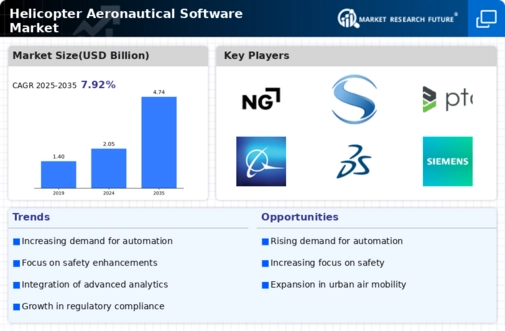The Helicopter Aeronautical Software Market is characterized by intense competition and innovation, driven by the increasing demand for advanced aeronautical technologies to enhance operational efficiency and safety in helicopter operations.
Stakeholders in this market range from software developers to aviation service providers, each contributing unique offerings tailored to meet the diverse needs of military and civilian helicopter applications. As the industry evolves, companies are leveraging advancements in artificial intelligence, data analysis, and simulation technologies to capture a larger share of the market.
The competitive landscape is marked by strategic partnerships, mergers and acquisitions, and continuous research and development efforts aimed at developing cutting-edge software solutions that comply with stringent regulatory requirements and respond to emerging challenges in helicopter operations.
In this competitive environment, Northrop Grumman stands out for its robust presence in the Helicopter Aeronautical Software Market, leveraging its deep-rooted expertise in defense and aerospace technology. The company is recognized for its innovative software solutions, which focus on enhancing flight safety, operational efficiency, and mission reliability.
Northrop Grumman's strengths lie in its advanced data analytics capabilities and a strong emphasis on cybersecurity, which is vital in a landscape where threats are increasingly sophisticated.
Moreover, the company has established a solid reputation for integrating its software into existing helicopter systems without disrupting operational workflows, making it a preferred partner among various military and commercial aviation sectors.
Its commitment to research and development also ensures that Northrop Grumman remains at the technological forefront, often leading the charge in developing next-generation software tools that anticipate future helicopter operational needs.
On the other hand, Safran has carved a niche for itself within the Helicopter Aeronautical Software Market through its focus on developing optimized software solutions that enhance the overall cockpit experience for pilots.
The company's strengths include its extensive experience in engine and aircraft systems integration, which allows for the seamless fusion of software applications with mechanical components.
Safran's software solutions often emphasize user-friendliness while delivering comprehensive functionalities that improve situational awareness and decision-making capabilities during flight operations.
The company is known for its strong commitment to customer service, often collaborating closely with clients to tailor solutions that meet specific operational requirements.
Furthermore, Safran's investments in innovation and technology ensure that it remains competitive in addressing the unique challenges faced by operators in the dynamic helicopter segment, enabling more effective maintenance, operational planning, and performance monitoring.


















Leave a Comment